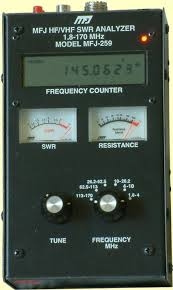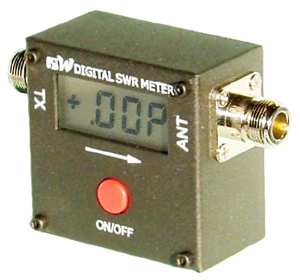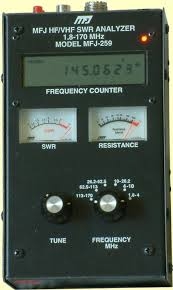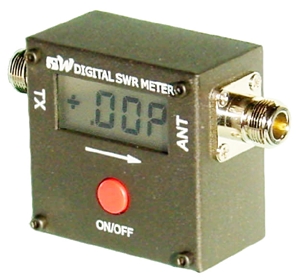 |
Matronics Email Lists
Web Forum Interface to the Matronics Email Lists
|
| View previous topic :: View next topic |
| Author |
Message |
dean.psiropoulos(at)veriz
Guest
|
 Posted: Thu Apr 24, 2014 8:25 pm Post subject: SL-30 Poor VOR reception Posted: Thu Apr 24, 2014 8:25 pm Post subject: SL-30 Poor VOR reception |
 |
|
Hello listers:
I have an RV-6A that I've been flying for a few years. When I first started
flying the airplane I did some rough VOR range reception checks with the
SL-30 and I had to get within 20 miles of a VOR station to get the receiver
to lock on and the OBS indicator to stabilize with no flag displayed. I
continued with the flight test regimen and getting familiar with the
airplane and enjoying it. Since flights have been in VFR conditions around
the busy Tampa (Florida) airspace I used the panel mounted moving map
(GPS/Comm) to make sure I stayed out of the Class B, there was no need to
have good VOR reception. The Com portion was the only thing I was using on
the SL-30 and that worked very well. Then, a couple months ago I turned on
the SL-30 and, nothing, no display or Com so I returned the unit to Garmin
for repair. In the meantime I'd been talking to a CFII about working on
my instrument proficiency to get back up to FAA standards after a long
hiatus. When the SL-30 was repaired and back in the instrument panel I took
off on a flight to Ocala to check it out. I climbed up to 4500 feet and
watched the OBS and listened for the ID code as I entered the 40 mile radius
of the Ocala VOR. Nothing so I kept going on a course straight for the
station. Around 20-25 miles out I started getting activity on the indicator
but the flags were intermittent and the radio could not maintain a lock.
Finally about 15 miles out the indicators stabilized and the flags stayed
off, obviously something is amiss.
I'm using a Comant CI-159 VOR/ILS antenna. This unit consists of a phenolic
"puck" with a BNC connector cast into it for the coax connection. There are
two fiberglas elements (thin rods about 18 inches long) that screw into the
puck to form a "V" shaped antenna. I have it mounted on the bottom of the
fuselage in the back of the airplane under the horizontal stabilizer. The
BNC sticks through a hole in the belly and appx 25 foot length of RG-58 coax
runs inside the aircraft up to the SL-30 receiver. No gasket was supplied
with the antenna so I just bolted the puck to the aluminum using the two
bolt holes. After the Ocala flight I removed the puck and elements for
closer inspection and checked the connector on the coax cable at the antenna
end. Nothing wrong that I could tell just by looking at the equipment.
There was a bit of engine oil (from the exhaust) on the puck surface facing
the skin. I cleaned it off and made a gasket to go between the puck and the
skin to minimize the oil build up again. I have not flown the airplane
since but I doubt that lack of a gasket was causing the poor reception,
maybe someone here can tell me. The other thing I checked was the
resistance between the center pin and outside barrel of the BNC connector on
the antenna. Resistance was showing basically a dead short (less than 1
ohm, same reading as touching the meter probes together). I'm not an
antenna designer so I don't know if this is what the reading should be or
not. Aircraft Spruce has the following description for this antenna: " "V"
Dipole VOR/Glide Slope Antenna with detachable elements is similar to the CI
158C-3 with the exception of offering 2-hole mount instead of a 4-hole
mount. This V Dipole encompasses reduced static capability with the use of
P-Stat paint. Integral ferrite balun provides for higher radiation
efficiency." . I don't know if the construction of the antenna would cause
the meter to show such a low resistance, maybe some here could shed some
light on that.
Any ideas, experiences with poor VOR reception here on the list? Since the
radio has been repaired and tested by the factory I'd say it's not the
radio. I checked the connector at the back of the radio tray and it appears
secure so I'm not sure what else to do. Since VORs are being decommissioned
there is going to be less and less need for VOR reception but if I have to
use victor airways during instrument operations I need to have good
reception at the expected range or I won't be able to comply with ATC
clearances. On an side note, a fellow RV-9 builder who is using a simple
flat metal antenna in the wingtip, has no problem receiving the VOR 40 miles
out, and he didn't pay anywhere near what I did for his antenna. Thanks for
the help
Dean Psiropoulos
RV-6A N197DM
200+ hours since 2008
| | - The Matronics AeroElectric-List Email Forum - | | | Use the List Feature Navigator to browse the many List utilities available such as the Email Subscriptions page, Archive Search & Download, 7-Day Browse, Chat, FAQ, Photoshare, and much more:
http://www.matronics.com/Navigator?AeroElectric-List |
|
|
|
| Back to top |
|
 |
nuckolls.bob(at)aeroelect
Guest
|
 Posted: Fri Apr 25, 2014 7:53 am Post subject: SL-30 Poor VOR reception Posted: Fri Apr 25, 2014 7:53 am Post subject: SL-30 Poor VOR reception |
 |
|
When the SL-30 was repaired and back in the instrument panel I took
off on a flight to Ocala to check it out. I climbed up to 4500 feet and
watched the OBS and listened for the ID code as I entered the 40 mile radius
of the Ocala VOR. Nothing so I kept going on a course straight for the
station. Around 20-25 miles out I started getting activity on the indicator
but the flags were intermittent and the radio could not maintain a lock.
Finally about 15 miles out the indicators stabilized and the flags stayed
off, obviously something is amiss.
Since the radio has enjoyed a recent bench check,
probability of it being a radio problem is considerably
reduced . . . at the bottom of the list . . .
I have not flown the airplane since but I doubt that lack of a gasket
was causing the poor reception, maybe someone here can tell me.
Agreed . . . gaskets tend to be hedges against
moisture/dirt and have no effect on performance
of any antenna.
The other thing I checked was the
resistance between the center pin and outside barrel of the BNC connector on
the antenna. Resistance was showing basically a dead short (less than 1
ohm, same reading as touching the meter probes together).
40 years ago, this would be uncommon. Nowadays, antenna
designers have deduced value for incorporation of impedance
matching a balancing networks between the antenna element(s)
and the feed line. Further, designing a network with a
DC path to ground is a further improvement for reduction of
noise due to p-static.
This V Dipole encompasses reduced static capability with the use of
P-Stat paint.
A further step forward in the art and science of antennas
for aircraft.
Integral ferrite balun provides for higher radiation efficiency."
Yeah . . . sort of . . . measurable in the lab but
of zero observable significance to the pilot.
I don't know if the construction of the antenna would cause
the meter to show such a low resistance, maybe some here could shed some
light on that.
Yes . . . your observations are not out of the
ordinary . . .
Any ideas, experiences with poor VOR reception here on the list? Since the
radio has been repaired and tested by the factory I'd say it's not the
radio. I checked the connector at the back of the radio tray and it appears
secure so I'm not sure what else to do. Since VORs are being decommissioned
there is going to be less and less need for VOR reception but if I have to
use victor airways during instrument operations I need to have good
reception at the expected range or I won't be able to comply with ATC
clearances. On an side note, a fellow RV-9 builder who is using a simple
flat metal antenna in the wingtip, has no problem receiving the VOR 40 miles
out, and he didn't pay anywhere near what I did for his antenna. Thanks for
the help.
A not uncommon observation. The quest for uber-efficient
antennas on aircraft is problematic. The guys with hammers-
n-saws in the lab can do a fine job of 'optimizing' a
design to textbook ideals but we're not communicating
with space probes or folks with hand-helds over the
horizon.
The nominal signal-to-noise ratios for air-to-ground
contact by radio are huge. For the most part, a "wet-string"
will offer serviceable performance as an antenna.
Do you have access to an antenna analyzer . . .
[img]cid:.0[/img]
or perhaps an SWR meter . . .
[img]cid:.1[/img]
The FIRST thing to do after checking the obvious (mechanical
connections) is to get some numbers. An antenna analyzer hooked
to the receiver end of the transmission line is the best
way to assess antenna health. Even use of an SWR meter
like the 'red dot' instruments off eBay can be excited with
the ship's comm transceiver (or a hand held) set to
the lowest comm frequency. The SWR should be relatively
low even though you're measuring at the top of it's
design range.
Put a dummy load
http://tinyurl.com/cchp3pf
at the antenna end of your VOR feed line, connect
the feedline to the transceiver and then "talk"
to it while monitoring SWR.
Alternatively, make a temporary connection of your
comm antenna into the VOR receiver input jack and
go fly the airplane. I'm betting that you're going
to see a marked improvement in VOR performance.
If your access to test equipment is limited,
you can play the swaptronics game . . . replace
the connectors on the ends of the feed line just
for the heck of it. It takes less time to do this
simple experiment than all the time spent thus
far looking for 'rate in the woodpile'.
It seems unlikely that the antenna is at fault.
feedline installation errors are a higher
probability.
What ever the problem is . . . it's stone simple
Bob . . .
| | - The Matronics AeroElectric-List Email Forum - | | | Use the List Feature Navigator to browse the many List utilities available such as the Email Subscriptions page, Archive Search & Download, 7-Day Browse, Chat, FAQ, Photoshare, and much more:
http://www.matronics.com/Navigator?AeroElectric-List |
|
| Description: |
|
| Filesize: |
26.49 KB |
| Viewed: |
3596 Time(s) |

|
| Description: |
|
| Filesize: |
57.02 KB |
| Viewed: |
3596 Time(s) |

|
|
|
| Back to top |
|
 |
user9253
Joined: 28 Mar 2008
Posts: 1948
Location: Riley TWP Michigan
|
 Posted: Fri Apr 25, 2014 9:32 am Post subject: Re: SL-30 Poor VOR reception Posted: Fri Apr 25, 2014 9:32 am Post subject: Re: SL-30 Poor VOR reception |
 |
|
There could be a problem with one of the coax connectors. You could replace the RG-58 cable with RG-400, which has less signal loss. If the coax is bent with too small of a radius, that can cause problems. Another concern is the antenna location. What is the distance between the horizontal stabilizer and the antenna? This distance can have a big affect on the antenna performance.
Radio Frequency current behaves much differently than DC current. An open circuit for DC can be a short circuit for RF. And a short circuit for DC can be an open circuit for RF.
Joe
| | - The Matronics AeroElectric-List Email Forum - | | | Use the List Feature Navigator to browse the many List utilities available such as the Email Subscriptions page, Archive Search & Download, 7-Day Browse, Chat, FAQ, Photoshare, and much more:
http://www.matronics.com/Navigator?AeroElectric-List |
|
_________________
Joe Gores |
|
| Back to top |
|
 |
skywagon
Joined: 11 Feb 2006
Posts: 184
|
 Posted: Fri Apr 25, 2014 10:12 am Post subject: SL-30 Poor VOR reception Posted: Fri Apr 25, 2014 10:12 am Post subject: SL-30 Poor VOR reception |
 |
|
Great advice by all concerning this problem . . . .
However, I would not place the fact that the radio just came out of factory bench testing on the bottom of the problem list.
I have had a few situations where factory repairs were very much less than acceptable.
The latest was an autopilot recalibration when GPS tracking was not accurate. Unit came back still with poor tracking. After much arguing with company, an officer went down to the final bench test and calibration station and found an error in the factory final test set-up.
Another was a Navigator that had very specific squelch breaks occurring at odd but, specific frequencies. Turned out the auto squelch factory test stand was set-up wrong.
I don't understand how such problems can exist in a well respected company but, it happens.
Let us know what you find with your radio problem. . .
[quote] ---
| | - The Matronics AeroElectric-List Email Forum - | | | Use the List Feature Navigator to browse the many List utilities available such as the Email Subscriptions page, Archive Search & Download, 7-Day Browse, Chat, FAQ, Photoshare, and much more:
http://www.matronics.com/Navigator?AeroElectric-List |
|
| Description: |
|
| Filesize: |
26.49 KB |
| Viewed: |
3591 Time(s) |

|
| Description: |
|
| Filesize: |
57.02 KB |
| Viewed: |
3591 Time(s) |

|
|
|
| Back to top |
|
 |
nuckolls.bob(at)aeroelect
Guest
|
 Posted: Fri Apr 25, 2014 11:04 am Post subject: SL-30 Poor VOR reception Posted: Fri Apr 25, 2014 11:04 am Post subject: SL-30 Poor VOR reception |
 |
|
At 01:12 PM 4/25/2014, you wrote:
| Quote: | Great advice by all concerning this problem . . . .
However, I would not place the fact that the radio just came out of factory bench testing on the bottom of the problem list.
I have had a few situations where factory repairs were very much less than acceptable.
The latest was an autopilot recalibration when GPS tracking was not accurate. Unit came back still with poor tracking. After much arguing with company, an officer went down to the final bench test and calibration station and found an error in the factory final test set-up.
Another was a Navigator that had very specific squelch breaks occurring at odd but, specific frequencies. Turned out the auto squelch factory test stand was set-up wrong.
I don't understand how such problems can exist in a well respected company but, it happens.
Let us know what you find with your radio problem. . . |
Another investigative test option is to attach
a VOR/COMM hand held to the antenna feed line
to rule out panel mounted radio problems.
Bob . . . [quote][b]
| | - The Matronics AeroElectric-List Email Forum - | | | Use the List Feature Navigator to browse the many List utilities available such as the Email Subscriptions page, Archive Search & Download, 7-Day Browse, Chat, FAQ, Photoshare, and much more:
http://www.matronics.com/Navigator?AeroElectric-List |
|
|
|
| Back to top |
|
 |
Kellym
Joined: 10 Jan 2006
Posts: 1706
Location: Sun Lakes AZ
|
 Posted: Fri Apr 25, 2014 1:48 pm Post subject: SL-30 Poor VOR reception Posted: Fri Apr 25, 2014 1:48 pm Post subject: SL-30 Poor VOR reception |
 |
|
I agree with connector issues. I do NOT agree with cable issues. Ever
since the VOR came on the scene, RG-58 has proved more than adequate on
factory built spam cans. Most have runs of over 20 ft from panel to top
of tail. Often with one or more connectors in the line. I had such on a
Cessna that would easily receive 100nm on H class VOR at 10,000 ft. I
could connect handheld to splitter for same antenna and it also would
receive same 100+ nm range. RG 142 and 400 are better, but not 6 times
better, which is the price difference. I doubt they are even 50% better.
On 4/25/2014 10:32 AM, user9253 wrote:
| Quote: |
There could be a problem with one of the coax connectors. You could replace the RG-58 cable with RG-400, which has less signal loss. If the coax is bent with too small of a radius, that can cause problems. Another concern is the antenna location. What is the distance between the horizontal stabilizer and the antenna? This distance can have a big affect on the antenna performance.
Radio Frequency current behaves much differently than DC current. An open circuit for DC can be a short circuit for RF. And a short circuit for DC can be an open circuit for RF.
Joe
--------
Joe Gores
Read this topic online here:
http://forums.matronics.com/viewtopic.php?p=422373#422373
|
| | - The Matronics AeroElectric-List Email Forum - | | | Use the List Feature Navigator to browse the many List utilities available such as the Email Subscriptions page, Archive Search & Download, 7-Day Browse, Chat, FAQ, Photoshare, and much more:
http://www.matronics.com/Navigator?AeroElectric-List |
|
_________________
Kelly McMullen
A&P/IA, EAA Tech Counselor # 5286
KCHD |
|
| Back to top |
|
 |
nuckolls.bob(at)aeroelect
Guest
|
 Posted: Sat Apr 26, 2014 7:30 am Post subject: SL-30 Poor VOR reception Posted: Sat Apr 26, 2014 7:30 am Post subject: SL-30 Poor VOR reception |
 |
|
At 04:47 PM 4/25/2014, you wrote:
| Quote: |
I agree with connector issues. I do NOT agree with cable issues.
Ever since the VOR came on the scene, RG-58 has proved more than
adequate on factory built spam cans. Most have runs of over 20 ft
from panel to top of tail. Often with one or more connectors in the
line. I had such on a Cessna that would easily receive 100nm on H
class VOR at 10,000 ft. I could connect handheld to splitter for
same antenna and it also would receive same 100+ nm range. RG 142
and 400 are better, but not 6 times better, which is the price
difference. I doubt they are even 50% better.
|
Agreed. The strength of vor transmitters and the
fundamentally line-of-sight operation makes
signal loss in coax a non-issue. The greatest
gain for a modern coax is in quality of insulation.
Legacy RG-58 is pvc and polyethylene while
the modern plastics are tefzel and more robust
cousins.
RG-400 and siblings are preferred for new
construction but I wouldn't replace RG-58
already in place.
Bob . . .
| | - The Matronics AeroElectric-List Email Forum - | | | Use the List Feature Navigator to browse the many List utilities available such as the Email Subscriptions page, Archive Search & Download, 7-Day Browse, Chat, FAQ, Photoshare, and much more:
http://www.matronics.com/Navigator?AeroElectric-List |
|
|
|
| Back to top |
|
 |
|
|
You cannot post new topics in this forum
You cannot reply to topics in this forum
You cannot edit your posts in this forum
You cannot delete your posts in this forum
You cannot vote in polls in this forum
You cannot attach files in this forum
You can download files in this forum
|
Powered by phpBB © 2001, 2005 phpBB Group
|






